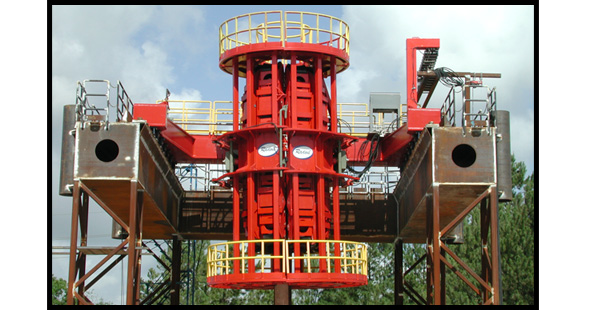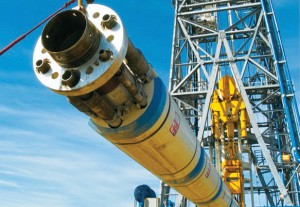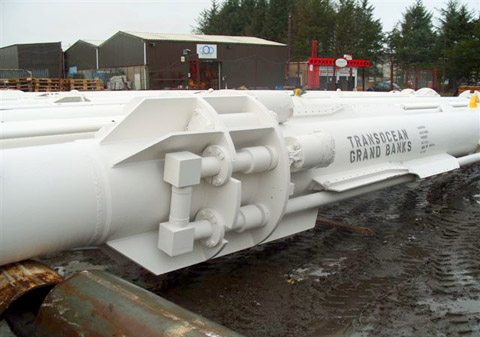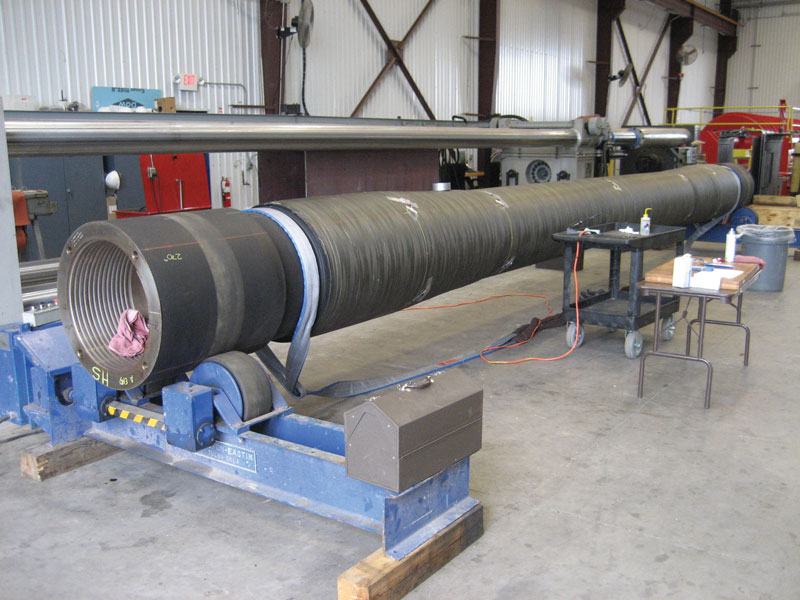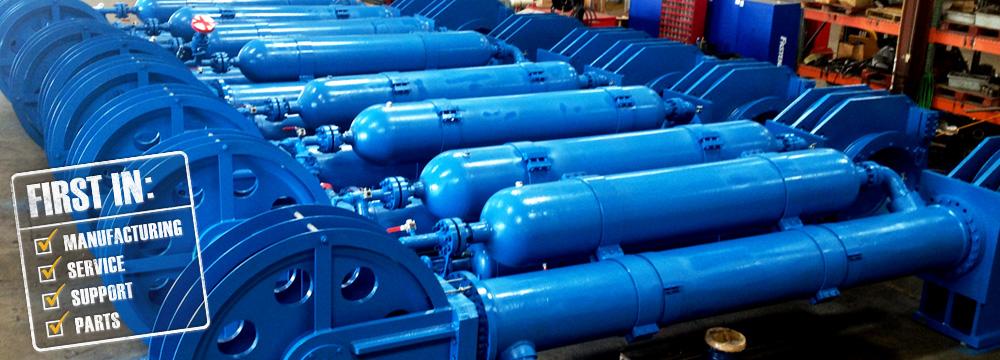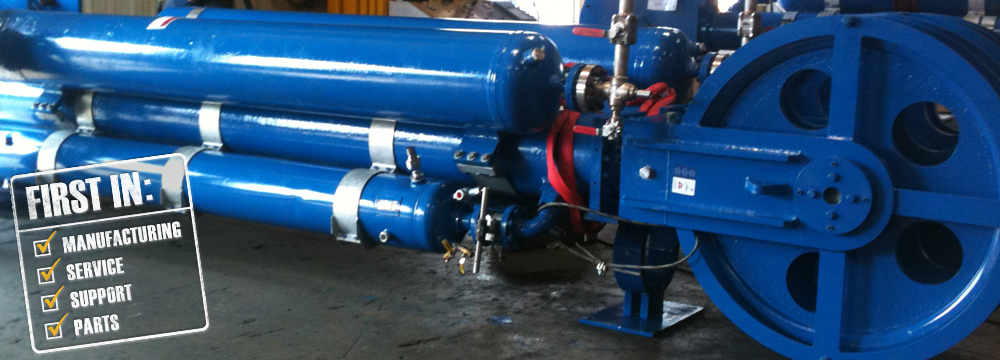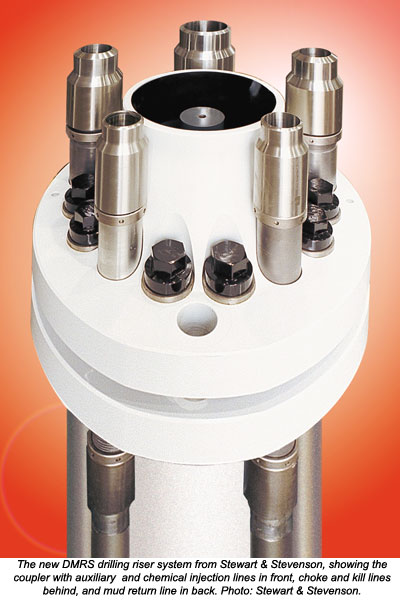
Hey Kent,
From what the OP is describing, it's a female plug like connector for a drill riser and they're used for both stationary onshore as well as offshore drilling rigs... Jholbert23 is describing what can look like a pipe flange like looking type of part that is called a "box" even though it's more than likely round in it's actual shape, hence the confusion from the nomenclature being used...
The marine riser or drilling riser can come in many different shapes... The dimensions will mainly depend on water depth and buoyancy needed... The traditional drilling riser is a large steel pipe with two smaller pipes on the outside (kill and choke)... It can also have some smaller piping for electric or hydraulic control... The main pipe is for drill pipe and drilling mud, while the choke and kill line are high‐pressure lines for well control... The total riser length consists of smaller joint in standard lengths connected together...
The typical joints can vary in standard lengths from 10 to 25m... One riser joint alone is a fairly stiff construction, but when they are put together for deep water drilling they have little global stiffness and depends on tension to guarantee a straight riser column... A straight column is critical for letting the drill pipe pass through and to not bend or buckle the construction... The application of tension to the riser happens by normally 4 or more hydraulic tensioners...
Now the questions are still many but I'll start with finding out whether or not that female connection he's describing is for the flex joints, or riser adapter to BOP (Blow Out Preventer), or riser to another riser etc...
Marine Drilling Risers from Risers International:
http://www.risersinc.com/Marine_Riser.htmAfglobalcorp Offshore Marine Drilling Risers and some images:
http://www.afglobalcorp.com/markets/oil-gas/offshoreRISER INSPECTOR:
https://www.youtube.com/watch?v=rS4tid-rUJYA whole bunch of Offshore Riser Installation Video's to watch:
https://www.youtube.com/results?search_query=Offshore+Riser+Installation+&spfreload=10Aker Solutions' Clip riser movie:
https://www.youtube.com/watch?v=5pzKQ4xwtx8Claxton Engineering:
http://www.claxtonengineering.com/offshore-case-studies/the-worlds-highest-pressure-large-bore-drilling-riser/http://www.claxtonengineering.com/products-services/drilling-risers/http://www.claxtonengineering.com/products-services/drilling-risers/hpht-drilling-riser-systems/?section=image-galleryDRIL-QUIP Riser Systems:
http://www.dril-quip.com/spar_production_drilling_riser.htmlhttp://www.dril-quip.com/resources/catalogs/12.%20Spar%20and%20TLP%20Drilling%20and%20Production%20Systems.pdfhttp://www.dril-quip.com/resources/catalogs/05.%20Rapid%20Deploy%20Marine%20Drilling%20Riser%20System.pdfSRP: Subsea and Riser Products:
http://www.srpsubsea.com/Nimway is SRP’s high-capacity quick-make-up completion & workover riser connector:
http://www.srpsubsea.com/products-services/risers/nimway/Riser flanges:
http://www.srpsubsea.com/products-services/risers/high-pressure-drilling-riser-flange/Project Services:
http://www.srpsubsea.com/products-services/project-services/General Electric Riser Connectors:
http://site.ge-energy.com/businesses/ge_oilandgas/en/prod_serv/systems/capital_drilling/shd.htmhttp://site.ge-energy.com/businesses/ge_oilandgas/en/prod_serv/systems/capital_drilling/mr_6e.htmVetcoGray HMF E-H Marine Riser:
http://www.ge-energy.com/products_and_services/products/capital_drilling_equipment/vg_hfm_e_h_marine_riser.jspVetcoGray MR-6E Marine Riser:
http://www.ge-energy.com/products_and_services/products/capital_drilling_equipment/vg_mr_6e_marine_riser.jspSCR (Steel Catenary Riser) welding:
https://www.youtube.com/watch?v=gPimIjTgFbEMARINE DRILLING RISER CONNECTOR WITH REMOVABLE SHEAR ELEMENTS - diagram, schematic, and image 03:
http://www.faqs.org/patents/imgfull/20100164223_03Technip Free Standing Hybrid Riser (FSHR):
http://www.technip.com/sites/default/files/technip/publications/attachments/FSHR_August%202013_Web.pdfTenaris Drilling Risers:
http://www.tenaris.com/en/Products/OffshoreLinePipe/Risers/DrillingRisers.aspxTenaris Video's:
http://www.tenaris.com/en/MediaAndPublications/Videos.aspxExperiment of a Catenary Riser@Yokohama National University 1/3
https://www.youtube.com/watch?v=3oSnLnnsG8kExperiment of a Catenary Riser@Yokohama National University 2/3
https://www.youtube.com/watch?v=_MNAnEJuWZUExperiment of a Catenary Riser@Yokohama National University 3/3
https://www.youtube.com/watch?v=DySuyqfATNwRiser internal Inspection with Spyball
https://www.youtube.com/watch?v=-2fLfUZXb7UPortable Ultrasonic Riser Inspection Tool
https://www.youtube.com/watch?v=iRWuoTme5oURiser Inspection Tool in Action
https://www.youtube.com/watch?v=-mg8wA3oTe8Splash Zone Riser Inspection Tool
https://www.youtube.com/watch?v=j0EzRcr0uLA Various ID and other Welding/Cladding Systems:
New Small ID Bore Cladding System from Arc Machines Inc.:
https://www.youtube.com/watch?v=yP5TrGvL_M0 This is from Jetline Engineering:
http://www.jetline.com/upload/bore%20clad.wmvhttp://www.jetline.com/photozoom.aspx?p=4C065F2EFEDC0449DF81621072ED849AEFAA2204703A3A783F1E4620EED3736397A72985B4DFCB2F79FCC35D10DB7DFBHere's a link to company that make portable auto bore welding equipment:
http://climaxportable.com/products/category/welding-machines/http://climaxportable.com/assets/BWCmp-E.pdfIn this link there are two video's of the Auto bore welding system in action... Check it out:
http://climaxportable.com/products/ac5000-autoclad-machine-3/Here's another one or two
http://climaxportable.com/products/bw3000-autoborewelder/http://climaxportable.com/products/bw5000-autoborewelder/These are from ARC Specialties out of Houston, Texas:
http://arcspecialties.com/?portfolio_entries=category-arc-05http://arcspecialties.com/?portfolio_entries=category-oil-and-gasArc Energy Resources - Weld Overlay Cladding Specialists:
https://www.youtube.com/watch?v=2dW4BD6UJjgAdvance Weld Overlay Cladding Technology(1).flv:
https://www.youtube.com/watch?v=JoensX8ig8kARC-05HVG PLC GTAW Horizontal and Vertical Bore Cladding Systems:
https://www.youtube.com/watch?v=rj8vCnzj9ig TriPulse Pipe Cladding System Video:
https://www.youtube.com/watch?v=750BJgqTJ-4&index=12&list=PLJ3JlxgOiT_DywSDed0FiL2MJj54J4cDGKLADARC:
https://www.youtube.com/watch?v=wSfgZESrO58 More cladding video's:
https://www.youtube.com/watch?v=wqtb8thHxxkThis is showing the part immobile and the GTAW torch attached to the head moving into position:
https://www.youtube.com/watch?v=lSlmfXyr6IQhttps://www.youtube.com/watch?v=dwmDjK-FaWQHere's TIP TIG from Ed Craig:
https://www.youtube.com/watch?v=y1yID2NXmRQTIP TIG - CLADDING (INCONEL 625):
https://www.youtube.com/watch?v=oBdHowyiEngHere's an Automatic internal cladding system Hot wire GTAW from Fronius Automation:
https://www.youtube.com/watch?v=o7jOTVcYlZENICO SYSTEM VERTICAL CLADDING MACHINE *Notice the Fronius Welding power sources:
https://www.youtube.com/watch?v=9ZhEDgEB1BUPolysoude : CRDM Cladding:
https://www.youtube.com/watch?v=XsmT6hwUT3Y Polysoude - Cladding with TIGer bi-cathode technology:
https://www.youtube.com/watch?v=DNUFGl2PefEMore from Polysoude:
https://www.youtube.com/results?q=Polysoude+-+Cladding+with+TIGer+by-cathode+technologyHere's a Laser ID Cladding System:
https://www.youtube.com/watch?v=kD_MaoDTMKE GMAW Inconel cladding internal:
https://www.youtube.com/watch?v=hxrUUns05gw 750 mm diameter Electroslag 60 X 0 5 mm , 309L Mo strip cladding:
https://www.youtube.com/watch?v=QUtvoRqFNnE Here's a Bugo GMAW Bore welder:
https://www.youtube.com/watch?v=3LgCYZjhNNUHere's one of my Boring friends in Nazareth, PA *Caution: Loud Rock music!:
https://www.youtube.com/watch?v=vipwTa9tg1wHere's a line boring machine used after the cladding is complete:
https://www.youtube.com/watch?v=qfsUY6UVVgIHere's a BOA GMAW Bore portable welder:
https://www.youtube.com/watch?v=_AgM9an4AlUBortech Corporation MIG Pipe Cladder:
https://www.youtube.com/watch?v=5H23Kg1_sq8 That's enough for now.



Respectfully,
Henry













 is it the same?
is it the same?








